
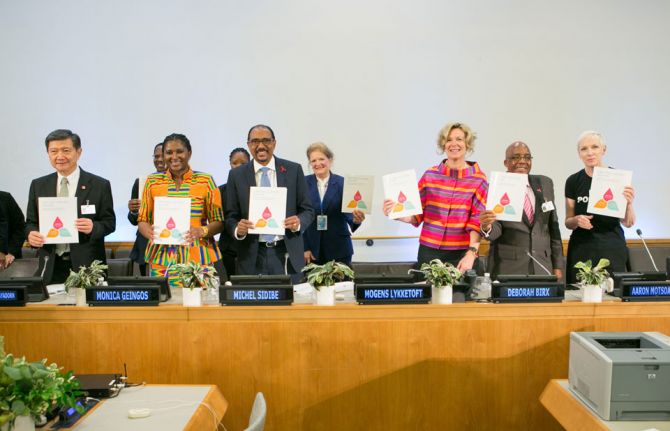
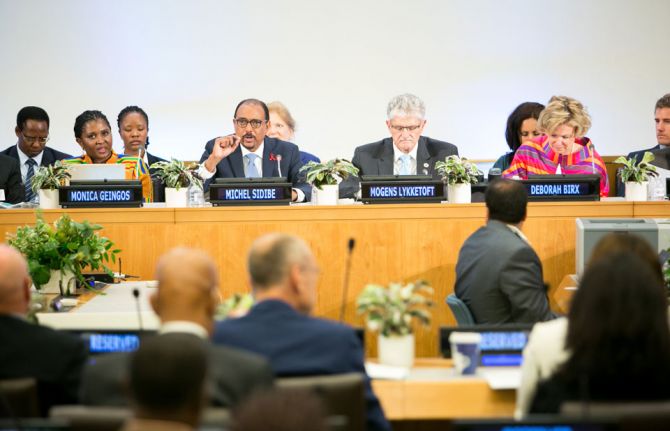
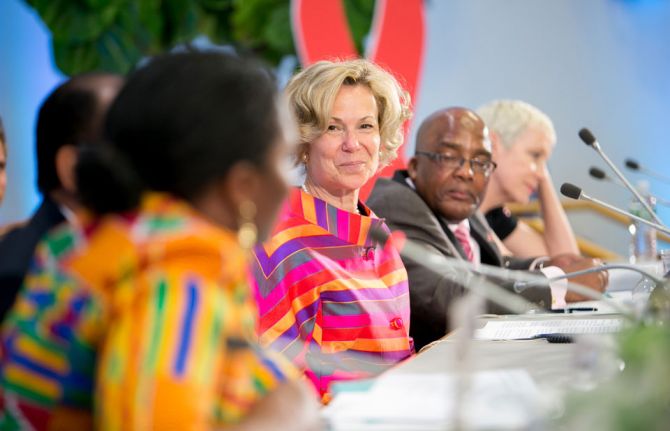
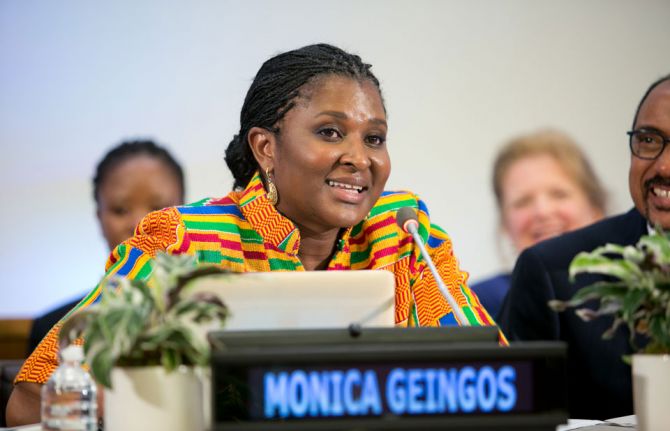

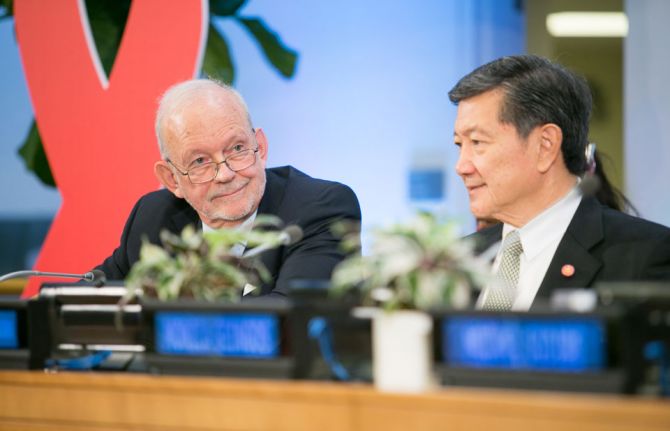
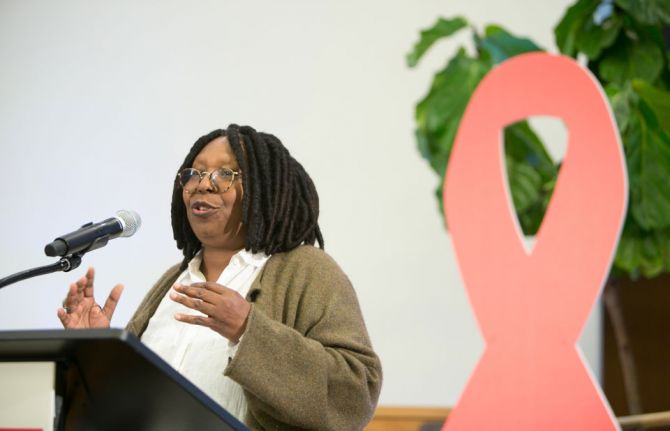
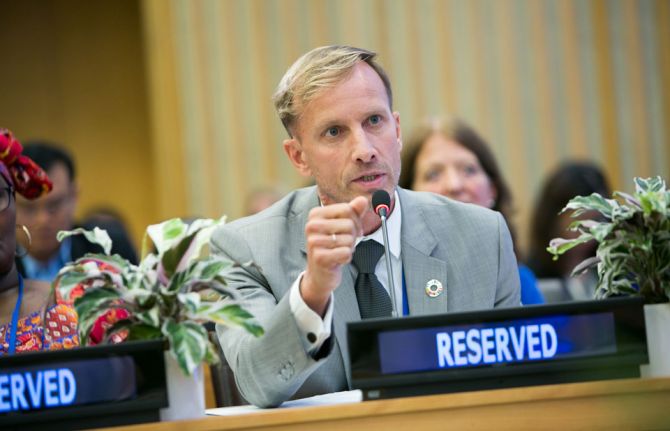
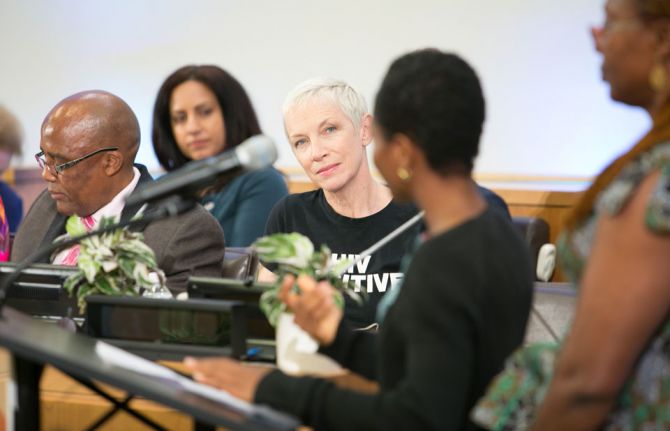
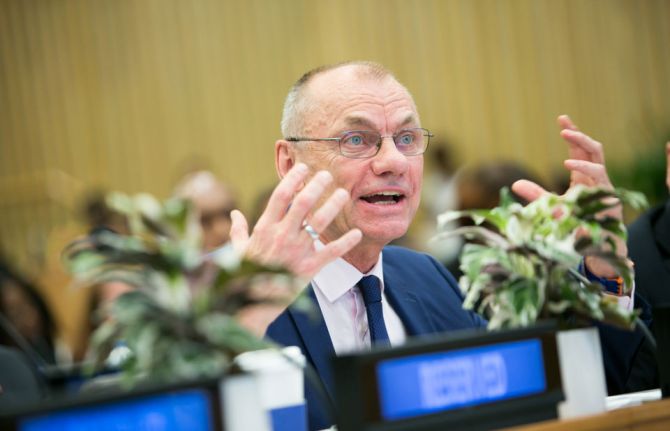
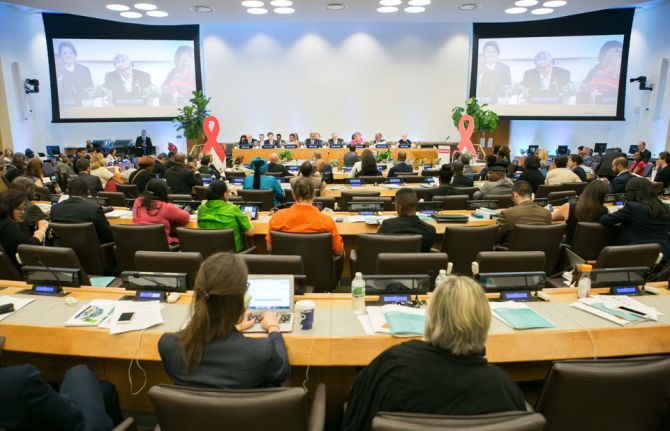
Press Release
UNAIDS and PEPFAR announce dramatic reductions in new HIV infections among children in the 21 countries most affected by HIV in Africa
08 June 2016 08 June 2016Concerted global efforts have led to a 60% drop in new infections among children, which has averted 1.2 million new HIV infections among children in 21 priority countries since 2009
NEW YORK/GENEVA, 8 June 2016—UNAIDS and the United States President’s Emergency Plan for AIDS Relief (PEPFAR) announced today that there has been a 60% decline in new HIV infections among children since 2009 in the 21 countries in sub-Saharan Africa that have been most affected by the epidemic.
New HIV infections among children in the 21 countries dropped from 270 000 [230 000–330 000] in 2009 to 110 000 [78 000–150 000] in 2015. Equally impressive are gains made in bridging the treatment gap among children. In 2005, fewer than one in 10 children had access to antiretroviral treatment—this gap has now been reduced to one in two. In the past five years alone, treatment scale-up for children grew twofold. The impact is that AIDS-related deaths among children were reduced by 44%.
“These astounding results show that the world is on the Fast-Track to eliminating new HIV infections among children and ensuring that their mothers are alive and healthy,” said UNAIDS Executive Director Michel Sidibé. “It’s beautiful to know that we could soon have a new generation free from HIV.”
The results were published in a new report, On the Fast-Track to an AIDS-free generation, which was launched at an event hosted by UNAIDS and PEPFAR on the opening day of the United Nations General Assembly High-Level Meeting on Ending AIDS, taking place in New York, United States of America, from 8 to 10 June.
“This shows what is possible through the combined power of science, communities and focused action,” said Deborah Birx, United States Global AIDS Coordinator and Special Representative for Global Health Diplomacy. “PEPFAR is building on this success, driving harder and smarter to prevent HIV infections and end AIDS among children, adolescents and young women through our DREAMS Partnership, Accelerating Children’s HIV/AIDS Treatment initiative and other efforts.”
During the event, UNAIDS also released global data for children that showed that new HIV infections among children have declined globally by 50% since 2010—down from 290 000 in 2010 to 150 000 in 2015. It also showed that 49% of children living with HIV around the world now have access to life-saving treatment. On the eve of the event, UNAIDS and partners announced that Armenia, Belarus and Thailand have joined Cuba in receiving official certificates of validation from the World Health Organization for eliminating new HIV infections among children. Thailand is the first country with a major HIV epidemic (450 000 people living with HIV in 2014) to receive such a validation.
It was during the High-Level Meeting on HIV and AIDS in 2011 that UNAIDS and PEPFAR joined with partners to launch the Global Plan towards the elimination new HIV infections among children by 2015 and keeping their mothers alive (Global Plan). The focus of the Global Plan was to increase efforts to prevent new HIV infections in all countries, but particularly in the 22 countries that, in 2009, accounted for 90% of pregnant women living with HIV.
The new report released today shows the progress made since the Global Plan was launched. It outlines that seven countries have reduced new HIV infections among children by more than 70% since 2009 (the baseline for the Global Plan), including: Uganda, by 86%; South Africa and Burundi, by 84%; Swaziland, by 80%; Namibia, by 79%; Mozambique, by 75%; and Malawi, by 71%. In Nigeria, however, the decline was much smaller, at just 21%. In India, the only Global Plan country outside of sub-Saharan Africa, new HIV infections in children dropped by 44% and coverage of services to pregnant women increased from less than 4% in 2010 to 31% in 2015.
The new report demonstrates that treatment or prophylaxis (excluding the less-effective single-dose nevirapine) coverage for pregnant women living with HIV in the countries most affected by the epidemic increased dramatically from 2009. By 2015, more than 80% of pregnant women living with HIV in the 21 countries in sub-Saharan Africa had access to medicines to prevent transmission of the virus to their child—up from just 36% (excluding the less-effective single-dose nevirapine) in 2009.
The World Health Organization recommends that all pregnant women living with HIV should be offered lifelong HIV treatment, extending beyond Option B+ to include all women diagnosed with HIV regardless of pregnancy. By 2015, all of the Global Plan countries, with the exception of Nigeria, were routinely offering lifelong HIV treatment to all pregnant women living with HIV. The massive scale-up of treatment has helped to reduce AIDS-related deaths among women of reproductive age, which declined by 43% between 2009 and 2015.
Incredible journey
Six countries—Botswana, Mozambique, Namibia, South Africa, Swaziland and Uganda—met the Global Plan goal of ensuring that 90% or more of pregnant women living with HIV had access to life-saving antiretroviral medicines. Six additional countries provided antiretroviral medicines to more than 80% of pregnant women living with HIV—Burundi, Cameroon, Malawi, the United Republic of Tanzania, Zambia and Zimbabwe.
Major successes have also been seen in increasing access to treatment for children living with HIV in the 21 countries: access has increased more than threefold since 2009—from 15% in 2009 to 51% in 2015. However, this is still only half of all children in need of treatment. Major efforts are required to ensure that all children born to HIV-positive mothers are tested for HIV within the first two months of life. Without immediate access to treatment, around 30% of children living with HIV will die within the first year of life and more than 50% will die before they reach their fifth birthday.
The Global Plan also aspired to reduce new HIV infections among women of reproductive age by 50%. The actual decline was just 5%—well below the target. This suggests that women, including young women, continue to be left behind and are not being reached with HIV prevention services. Between 2009 and 2015, around 4.5 million [3.8 million–5.4 million] women became newly infected with HIV in the 21 priority countries in sub-Saharan Africa, and AIDS-related illnesses remain the leading cause of death among adolescents on the continent.
At the launch of the report, UNAIDS, PEPFAR and partners also launched a Super Fast-Track framework for ending AIDS among children, adolescents and young women—Start Free, Stay Free, AIDS-Free. The initiative will build on the progress already made to Fast-Track action to end the AIDS epidemic and sets ambitious targets to eliminate new infections among children, find and ensure access to treatment for all children living with HIV and prevent new HIV infections among adolescents and young women. Together, these steps will put the world on a path to ending AIDS among children.
UNAIDS
The Joint United Nations Programme on HIV/AIDS (UNAIDS) leads and inspires the world to achieve its shared vision of zero new HIV infections, zero discrimination and zero AIDS-related deaths. UNAIDS unites the efforts of 11 UN organizations—UNHCR, UNICEF, WFP, UNDP, UNFPA, UNODC, UN Women, ILO, UNESCO, WHO and the World Bank—and works closely with global and national partners towards ending the AIDS epidemic by 2030 as part of the Sustainable Development Goals. Learn more at unaids.org and connect with us on Facebook, Twitter, Instagram and YouTube.
PEPFAR
The United States President’s Emergency Plan for AIDS Relief (PEPFAR) is the United States Government initiative to save the lives of those affected by HIV/AIDS around the world. This historic commitment is the largest by any nation to combat a single disease internationally, and PEPFAR investments also help alleviate suffering from other diseases across the global health spectrum. PEPFAR is driven by a shared responsibility among donor and partner nations and others to make smart investments to save lives. Learn more at pepfar.gov and connect with us on Facebook and Twitter.
Contact
UNAIDSSophie Barton-Knott
tel. +41 22 791 1697
bartonknotts@unaids.org
PEPFAR
David Haroz
tel. +1 202 445 3269
harozd@state.gov
Press centre
Download the printable version (PDF)
